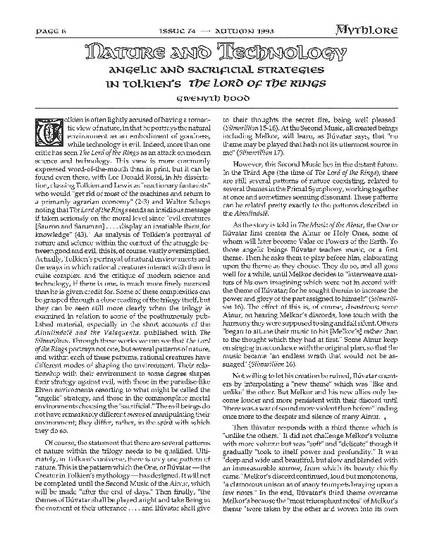
Tolkien is often lightly accused of having a romantic view of nature, in that he portrays the natural environment as an embodiment of goodness, while technology is evil. Indeed, more than one critic has seen The Lord of the Rings as an attack on modem science and technology. This view is more commonly expressed word-of-the-mouth than in print, but it can be found even there, with Lee Donald Rossi, in his dissertation, classing Tolkien and Lewis as "reactionary fantasists" who would "get rid of most of the machines and return to a primarily agrarian economy" and Walter Scheps noting that The Lord of the Rings sends an insidious message if taken seriously on the moral level since "evil creatures [Sauron and Saruman] .... display an insatiable thirst for knowledge.” As analysis of Tolkien's portrayal of nature and science within the context of the struggle between good and evil, this is, of course, vastly oversimplied. Actually, Tolkien's portrayal of natural environments and the ways in which rational creatures interact with them is quite complex, and the critique of modem science and technology, if there is one, is much more finely nuanced than he is given credit for. Some of these complexities can be grasped through a close reading of the trilogy itself, but they can be seen still more clearly when the trilogy is examined in relation to some of the posthumously published material, especially in the short accounts of the Ainulindalё and the Valaquenta, published with The Silmarillion. Through these works we can see that The Lord of the Rings portrays not one, but several patterns of nature, and within each of these patterns, rational creatures have different modes of shaping the environment. Their relationship with their environment to some degree shapes their strategy against evil, with those in the paradise-like Elven environments resorting to what might be called the "angelic" strategy, and those in the commonplace mortal environments choosing the "sacrificial." The evil beings do not have remarkably different means of manipulating their environment; they differ, rather, in the spirit with which they do so.

The version of record is available from Mythlore, which is published by the Mythopoeic Society at http://www.mythsoc.org/mythlore/. Mythlore is a scholarly, peer-reviewed journal that focuses on the works of J.R.R. Tolkien, C.S. Lewis, Charles Williams, and the genres of myth and fantasy. Copyright © 1993 the author. All rights reserved.